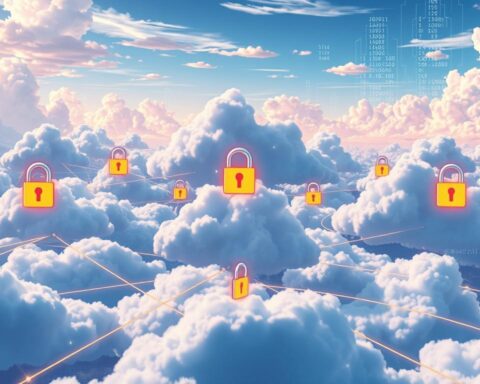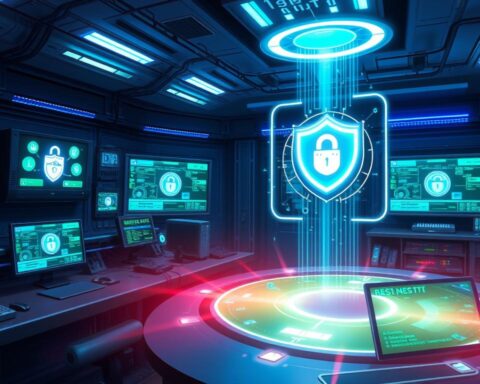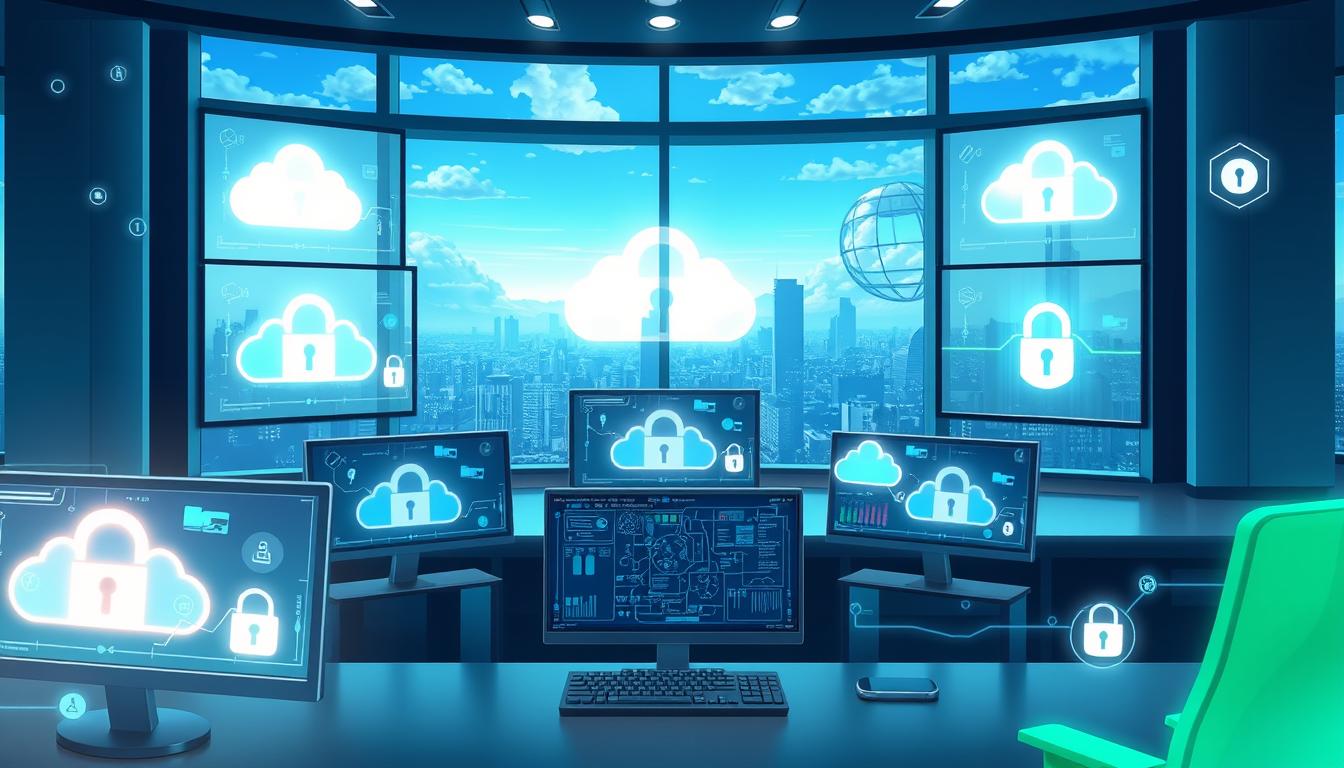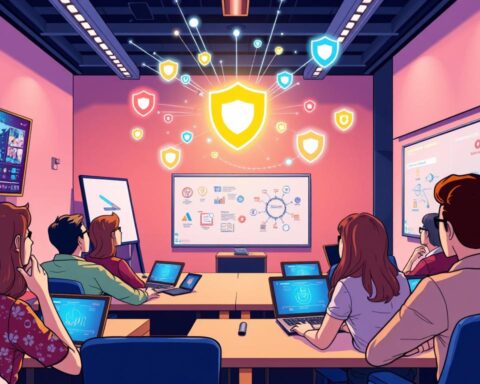A huge 95% of cyberattacks succeed because of human mistakes, like ignoring security rules or falling for phishing scams1. This shows how vital cybersecurity is for teams working from home. Keeping a remote workforce safe is key for businesses today. Cyber-attacks can cause big financial losses and harm a company’s reputation.
With more people working from home, companies face new security threats. Social engineering, which makes up nearly 50% of cyber attacks2, and ransomware requests that usually cost between $200 to $500 for decryption keys2 are big concerns.
Keeping antivirus software up to date can stop up to 93% of malware infections2. Also, using two-factor authentication can cut the risk of account breaches by over 99%2. As we explore remote work security, it’s vital to know how to keep a remote workforce safe. This includes best practices and tips for remote work security and cybersecurity for remote teams.
Key Takeaways
- Securing a remote workforce is key for businesses to avoid cyber-attacks and financial losses.
- Human error is a big reason for successful cyberattacks, so employee training and awareness are critical.
- Using two-factor authentication and keeping antivirus software updated can greatly lower cyber threat risks.
- Remote work security needs a full approach, including best practices and tips for remote teams.
- Cybersecurity for remote teams is vital to protect against social engineering, ransomware, and other cyber threats.
Understanding Remote Workforce Security Challenges
As more people work from home, companies face new security issues. Keeping remote workers safe is key to avoid big security problems. About 60% of remote workers face phishing attacks, compared to 16% in offices3. This shows how important it is to protect remote workers and have strong security plans.
Checking for risks in remote teams is a big part of keeping them safe. Companies with good endpoint security can cut malware by up to 80%3. Also, having good backup plans helps recover from attacks faster than without3. Here are some common threats in remote work:
- Phishing attacks
- Malware and ransomware
- Unauthorized access to confidential data
Companies should focus on keeping remote workers safe. This means giving them regular security training. By following best practices, companies can protect their remote teams and avoid expensive security issues4.
Understanding remote work security challenges helps companies act early. They can use strong authentication, encrypt data, and train remote workers. By focusing on remote workforce protection, companies can keep their remote work safe and secure3.
Essential Components of Securing a Remote Workforce
Securing a remote workforce requires several key elements. These include remote work data security, remote work compliance, and remote access security. By 2025, it’s expected that about 36 million Americans will work remotely5. This rise in remote work has led to a 238% increase in cyberattacks on work-from-home employees5.
To fight these risks, companies must set up strong security systems. This includes a “least privilege” access control system, which needs extra setup for better security5. Using two-factor authentication (2FA) makes it harder for unauthorized access and boosts data security5. Having a clear cybersecurity policy can also lower the chance of a cyberattack or data breach5.
Some important stats show why remote work security is critical:
- Phishing attacks cause over 80% of security incidents in companies6.
- About 30% of phishing emails are opened by employees, risking sensitive data6.
- Reports show 60% of businesses have faced phishing attacks linked to remote work6.
By knowing these risks and using strong security, companies can keep their remote workforces safe. This ensures the security and compliance of their remote work operations.
Implementing Robust Authentication Systems
Securing a remote workforce needs a strong plan, including good authentication systems. This is key for remote work security. It stops unauthorized access to company systems and data. About two-thirds of American workers do some remote work7, showing the need for strong cybersecurity.
To boost cybersecurity for remote teams, companies can use multi-factor authentication and single sign-on. These steps help stop unauthorized access and lower security breach risks. With more remote work, 71% of companies faced more cyberattacks8, making strong authentication systems even more vital.
Managing passwords well is also important. Weak or stolen passwords cause about 80% of data breaches9. Using multi-factor authentication can greatly lower security risks.
Strong authentication systems help protect remote workers from security breaches. This includes using VPNs for safe data transfer and RBAC for access control. With more people working remotely, it’s critical for companies to focus on securing a remote workforce and invest in good cybersecurity.
Remote Access Infrastructure and VPN Solutions
Securing remote employees is key to protect company systems and data. Remote access infrastructure and VPN solutions are vital for this purpose10. VPNs create a secure, encrypted tunnel for remote access to corporate networks. This ensures all data is encrypted, keeping it confidential and intact10.
Using multi-factor authentication and advanced encryption is common in VPN solutions10. VPNs also give employees safe access to company networks, databases, and cloud systems. This reduces the risk of unauthorized access11. By hiding IP addresses, VPNs prevent third parties from tracking user activity, which is vital for handling sensitive info11.
Some benefits of using VPNs for remote work include:
- Secure access to company networks and data
- Encryption of internet traffic
- Protection against cyber threats
- Flexibility and productivity improvements
It’s important to pick a VPN provider with a strict no-logs policy and strong encryption like AES-256. This ensures the highest protection against hacking11. By setting up strong remote access infrastructure and VPN solutions, organizations can protect remote work data security and securing remote employees10.
Data Protection Strategies for Remote Teams
Remote work is on the rise, making cybersecurity for remote teams a key focus. It’s vital to have strong data protection plans to avoid security breaches. Remote work security steps like encryption and secure file sharing are essential to fight cyber threats.
Studies show that more companies are spending on remote work security, with 60% focusing on physical security12. Yet, 45% of remote workers feel less secure at home than in the office12. To fix this, companies should offer training on physical security. This can cut security incidents by 50% related to remote work12.
Some important data protection strategies include:
- Implementing encryption to safeguard sensitive data
- Using secure file sharing to block unauthorized access
- Regular security audits to spot vulnerabilities
By focusing on remote work security and using these strategies, companies can lower data breach risks. Research shows that companies with good cybersecurity can cut financial losses from cyberattacks by 50%13. Investing in remote work security helps protect assets and keeps employees and customers trusting the company.
Employee Training and Security Awareness
Securing a remote workforce needs a full plan that includes training and awareness. Cybersecurity training for remote employees is key to stop security breaches and keep employees up-to-date on cyber threats. Regular training can cut phishing attack success by 30% when done right14. Also, firms that keep training see a 50% drop in security issues caused by human mistakes14.
Training for security awareness helps build a culture of security in companies. It’s vital to have clear remote work security rules and keep remote workers educated. This can be done with regular updates and phishing tests, which can boost employees’ skills by 40%14. Companies that make training mandatory see a 75% rise in employee awareness, leading to better security habits14.
Important parts of training and awareness for remote work include:
- Learning security best practices to avoid breaches
- Knowing how to handle security incidents
- Keeping up with security education to stay safe
By investing in training and awareness, companies can lower cyber risks and protect their remote teams. This ensures a safe remote workforce and strong security for remote teams.

Conclusion: Maintaining Long-term Remote Workforce Security
As more people work from home, keeping remote work safe is key. Companies must protect their remote workers to avoid security risks15. It’s important to keep data safe, as losing it can harm a company’s reputation for a long time16.
Using zero trust network access (ZTNA) and application allowlisting can make remote work safer. It’s also important to protect remote devices with the same security as company computers15. Tools like Slack and Zoom help teams work better, but they must be secure to avoid risks15.
To learn more about keeping remote work safe, check out remote workforce security. Also, visit Miloriano to find out about the top cyber threats and how to stay safe16.
FAQ
What are the most common security threats in remote work?
Why is a risk assessment for distributed teams essential?
What are the essential components of securing a remote workforce?
How can businesses implement robust authentication systems for remote workers?
What is the importance of remote access infrastructure and VPN solutions for remote teams?
What data protection strategies are critical for remote teams?
Why is employee training and security awareness important for securing a remote workforce?
What is required to maintain long-term remote workforce security?
Source Links
- 52 Cybersecurity Tips for Personal or Business Application You Need in 2019 – https://www.drizgroup.com/driz_group_blog/52-cybersecurity-tips-for-personal-or-business-application-you-need-in-2022
- 131 Cybersecurity Tips that Anyone Can Apply – https://heimdalsecurity.com/blog/cyber-security-tips/
- What Is Remote Work Security? Securing Remote Workforces – https://www.enterprisenetworkingplanet.com/security/remote-work-security/
- Security complexities of the remote workforce – https://www.securitymagazine.com/articles/101190-security-complexities-of-the-remote-workforce
- Network Security for Remote Workers: Best Practices for Securing Remote Access and Data Sharing – Perry proTECH – https://perryprotech.com/blog/network-security-for-remote-workers-best-practices-for-securing-remote-access-and-data-sharing/
- What is Remote Work Security? How to Secure the Remote Workforce – Citrix – https://www.citrix.com/glossary/what-is-remote-work-security.html?srsltid=AfmBOoolPqwy5irpK8ZLzBPYdoNUHd4oy7yTyZ28a6oL_Uc7IUzrL0jQ
- Securing Your Systems with Remote Workers | Taylored Systems – https://www.taylored.com/blog/securing-your-systems-with-remote-workers/
- Securing Remote Workforces: Challenges and Strategies – https://www.linkedin.com/pulse/securing-remote-workforces-challenges-strategies-joseph-n-mtakai-czjzf
- Best Practices for Securing Remote Work Environments. – https://demandteq.com/best-practices-for-securing-remote-work-environments/
- What Is a Remote Access VPN? – https://www.paloaltonetworks.com/cyberpedia/what-is-a-remote-access-vpn
- Why Are VPNs Important for Remote Work? – https://circleid.com/guides/vpn-for-remote-workers
- Security Strategies for Remote Workers – Security Industry Association – https://www.securityindustry.org/2024/06/12/security-strategies-for-remote-workers/
- Remote Work Security: Safeguarding Your Data and Privacy – https://www.remotepass.com/blog/remote-work-security
- Enhancing Your Cybersecurity Training Program for Remote Workers: 7 Essential Tips – https://www.linkedin.com/pulse/enhancing-your-cybersecurity-training-program-remote-workers
- Permanent Remote Workforce? 14 Questions to Consider ASAP – https://invenioit.com/security/remote-workforce/?srsltid=AfmBOoq9wzy3-qNFWQcA7uIDTJpSe6Jtr_ZX__y2SIE1LRHA__hhjtHr
- How to Maintain Security When Employees Work Remotely – Lantech Group – https://lantechgrp.com/how-to-maintain-security-when-employees-work-remotely/










